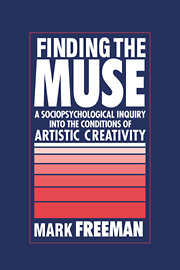Book contents
- Frontmatter
- Contents
- Acknowledgments
- Chapter 1 SOCIAL REALITY AND THE SPACE OF CREATIVITY
- Chapter 2 TO BE AN ARTIST
- Chapter 3 IN THE COMPANY OF OTHERS
- Chapter 4 CREATIVITY AND THE MARKET
- Chapter 5 THE DREAM OF ARTISTIC FREEDOM
- Chapter 6 THE CONDITIONS OF CREATIVITY
- Appendix: The Artists Project
- References
- Index
Chapter 1 - SOCIAL REALITY AND THE SPACE OF CREATIVITY
Published online by Cambridge University Press: 04 December 2009
- Frontmatter
- Contents
- Acknowledgments
- Chapter 1 SOCIAL REALITY AND THE SPACE OF CREATIVITY
- Chapter 2 TO BE AN ARTIST
- Chapter 3 IN THE COMPANY OF OTHERS
- Chapter 4 CREATIVITY AND THE MARKET
- Chapter 5 THE DREAM OF ARTISTIC FREEDOM
- Chapter 6 THE CONDITIONS OF CREATIVITY
- Appendix: The Artists Project
- References
- Index
Summary
INTRODUCTION
This book grows out of an abiding fascination with three distinct, yet interrelated, spheres of human experience. The first and broadest of these spheres has to do with the interpretive study of lives, specifically the narratives people tell about who they have been, who they are, and what they have done across the course of time. This is not to say that my interest here is purely retrospective, in the sense of focusing on the “storied” dimension of experience alone, for the stories people tell about themselves often contain revealing information about their own courses of development as well and how these have variously been enhanced or impeded by the social worlds through which they have moved. In this respect, inquiring into life histories can be of service in exploring not only the psychological realm but, in addition, the social, the cultural, and the historical. Indeed, a primary contention of this work is that there is no separating these realms from one another, except perhaps for analytic purposes: A human life, insofar as it exists in society, culture, and history, cannot help but tell us about the mode of its construction, about the complex interplay of influences responsible in significant part for its very shape.
The second sphere of interest is the psychology of art and creativity. In certain important respects, this second sphere grows directly out of the first, particularly if creativity, broadly conceptualized, is seen as a subspecies of the developmental process more generally.
- Type
- Chapter
- Information
- Finding the MuseA Sociopsychological Inquiry into the Conditions of Artistic Creativity, pp. 1 - 35Publisher: Cambridge University PressPrint publication year: 1994



